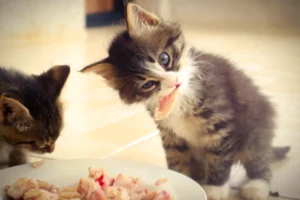Note: We may earn a commission from helpful, relevant links in our content. No cost to you. See our privacy policy.

Cats have mastered the art of acting as if they’re the ones doing us a favor by living in our homes. If your feline friend prefers the call of the wild, you might constantly worry about what adventures—and meals—they’re finding outdoors. Taking control over their diet doesn’t have to feel like herding cats.
Here’s a promise: you’ll walk away knowing the ins and outs of selecting the best dry cat food that keeps your outdoor explorer thriving, satisfied, and, most importantly, healthy enough to continue their backyard shenanigans.
Quick Takeaways:
- Look for high-protein dry cat foods with real meat as the first ingredient and added nutrients like taurine for your outdoor cat’s adventurous lifestyle.
- Transition to new foods gradually over a week to avoid digestive upsets, and consider warming the food slightly to make it more appealing.
- Feed outdoor cats twice daily, adjusting portion sizes for their activity level, and always provide fresh water to prevent dehydration.
Why is choosing the right dry food for outdoor cats so crucial?
Outdoor cats lead a thrilling life of exploration and adventure. Unlike their indoor counterparts, they spend their days scaling fences, chasing critters, and patrolling their territory – activities that demand a significant amount of energy.
This active lifestyle doesn’t just burn calories; it also exposes them to various climates, potentially increasing their dietary requirements to stay healthy, hearty, and ready for the next escapade. Hence, selecting a nourishing dry food tailored to their needs isn’t just about filling their bellies; it’s about fueling their adventurous spirit while ensuring they get the right balance of nutrients to thrive in the great outdoors.
What makes a dry cat food “the best” for outdoor cats?
Identifying top-notch dry food for your outdoor furball involves combing through the ingredient list for several key components:
- High Protein: This is non-negotiable. Outdoor cats need a protein-packed diet to support muscle repair and energy levels. Look for foods with real meat, fish, or poultry as the first ingredient.
- Healthy Fats: These are crucial for energy and help maintain a glossy coat. Sources like fish oil are excellent for omega-3 fatty acids, which support coat health and cognitive function.
- Added Vitamins and Minerals: Tailored nutrition should include vitamins E and C for immune health, plus a blend of calcium and phosphorus for strong bones and teeth.
- Taurine: An essential amino acid for cats, taurine supports heart and eye health, critical for a cat with a large territory to patrol.
Unique Tip: One frequently overlooked aspect is the kibble size and texture, which can hugely impact an outdoor cat’s dental health. Specially designed kibble that encourages chewing can help reduce tartar buildup, an issue for many outdoor cats who might not have regular dental check-ups.
So, while scanning the shelves, don’t just grab any bag; remember, the best dry food will serve as both fuel and protection for your adventurous feline friend.
How can you transition your outdoor cat to a new dry food smoothly?
Switching foods can be a finicky business, especially for the explorer in your backyard. Here’s how to make it a smooth transition:
-
Start Slow : Begin by mixing a small amount of the new food with their current diet. Gradually increase the new food’s proportion over a week. This slow introduction helps their digestive system adapt without too much stress.
-
Monitor Their Response : Keep an eye on their appetite, behavior, and poop. Any drastic changes could signify that the new diet isn’t sitting well, and you might need to slow down the transition or reconsider the food choice.
-
Stay Consistent : Once you’ve fully switched over, try to stick to the new food without mixing in old brands or flavors. Consistency helps their digestion adapt to the new diet.
And here’s an insider tip: outdoor cats sometimes prefer their food a tad warmer than room temperature, as it mimics the warmth of fresh prey. Warming the new dry food slightly can make it more appealing and may ease the transition. Just ensure it’s not hot and always check the temperature before serving.
By following these steps, your outdoor adventurer will soon be thriving on their new diet, ready to tackle whatever adventure comes next without missing a beat.
Remember, this is just the beginning of optimizing your outdoor cat’s health and happiness through nutrition. Dive deeper into capacities like hydration strategies and the importance of vet check-ups for a comprehensive wellness approach.
Sure, let’s dive right in with crafting your blog post.
What Are the Top Picks for Outdoor Cat Dry Food?
Choosing the right dry food for your outdoor cat isn’t just about satisfying their hunger pangs; it’s about fueling their adventurous lives. Outdoor cats live a life full of exploration, and their diet needs to be packed with nutrients to match their energy expenditure. Here, we break down some of the top picks that cater specifically to the rugged lifestyle of outdoor felines.
-
Blue Buffalo Wilderness High Protein : Packed with high-quality chicken, this grain-free formula is perfect for maintaining the lean muscles of an active outdoor cat. It’s enriched with omega fatty acids to ensure a shiny coat and healthy skin, antioxidants for a robust immune system, and sufficient fiber to aid in digestion.
-
Purina Pro Plan SAVOR : Combining crunchy kibble with tender, shredded pieces, Purina Pro Plan SAVOR offers a texture that cats love. It’s rich in protein from real chicken and beef, supports a healthy immune system, and it’s fortified with live probiotics for digestive health.
-
Taste of the Wild Grain-Free : This option caters to the wild side of your cat with ingredients like smoked salmon and roasted venison. It provides a balanced diet with fruits and vegetables, delivering antioxidants to help maintain an overall healthy lifestyle.
-
Hill’s Science Diet Oral Care : Outdoor cats are as prone to dental issues as their indoor counterparts. This choice from Hill’s not only supports overall health but also incorporates a unique technology to help clean teeth as your cat chews.
Unique Tip : One aspect often overlooked is the kibble size. Smaller kibble might be easier for kittens and senior cats to eat, but larger kibble can help maintain dental health in adult cats by encouraging chewing. Let your cat try different sizes to see what they prefer, and what supports their dental health best.
How Often Should Outdoor Cats Be Fed, and How Does It Differ From Indoor Cats?
Feeding outdoor cats presents a unique set of challenges compared to their indoor counterparts. Their active lifestyle means they’ll likely need more calories than an indoor cat, but how much more can be a fine line between maintaining a healthy weight and overfeeding.
-
Frequency : Ideally, outdoor cats should be fed twice daily – once in the morning and once in the evening. This mirrors the natural hunting patterns of felines and helps keep them from roaming too far in search of food.
-
Portion Size : The portion size should be adjusted based on the cat’s weight, age, and activity level. A widely accepted guideline is to feed them approximately 20 calories per pound of body weight, but active outdoor cats may require more. It’s always best to consult with a veterinarian to determine the exact needs of your pet.
-
Consistency and Safety : Feed your outdoor cat at the same times every day to create a routine. Use a heavy, sturdy bowl that cannot be easily tipped over or carried off by other animals. Moreover, ensure the feeding area is in a safe, sheltered location to protect your cat from the elements and predators.
-
Water : Always have fresh water available. Outdoor cats can get dehydrated quickly, especially in hot weather or if they are very active. Consider setting up multiple water stations in safe areas.
A Pro Tip Most Miss : Consider microchipping and placing a collar with an ID tag on your outdoor cat. This ensures that if they stray too far or get lost, they can be easily identified and returned to you. Moreover, investing in a microchip-activated cat feeder can prevent wildlife or other outdoor pets from consuming your cat’s food, ensuring your cat receives the nutrition you’ve carefully selected for them.
Feeding outdoor cats doesn’t have to be a puzzle. With the right food choice and feeding schedule, you can keep your adventurous feline friend healthy, happy, and ready to explore the great outdoors.
Alex, a passionate animal lover, has experience in training and understanding animal behavior. As a proud pet parent to two dogs and three cats, he founded AnimalReport.net to share insights from animal experts and expand his knowledge of the animal kingdom.









